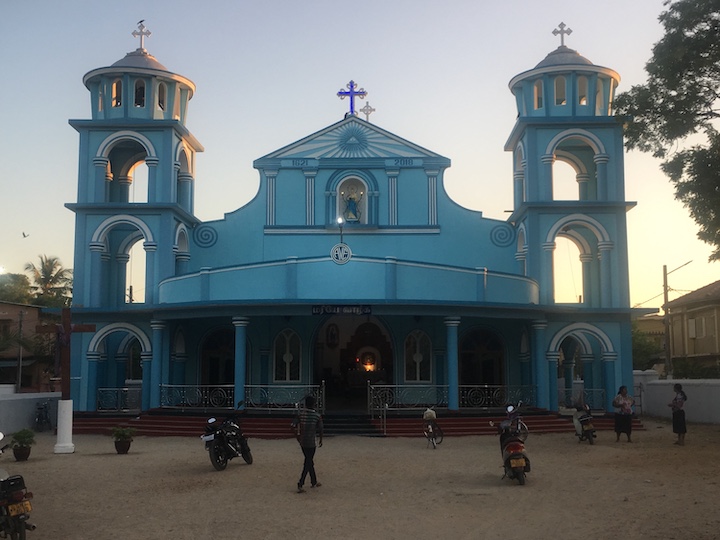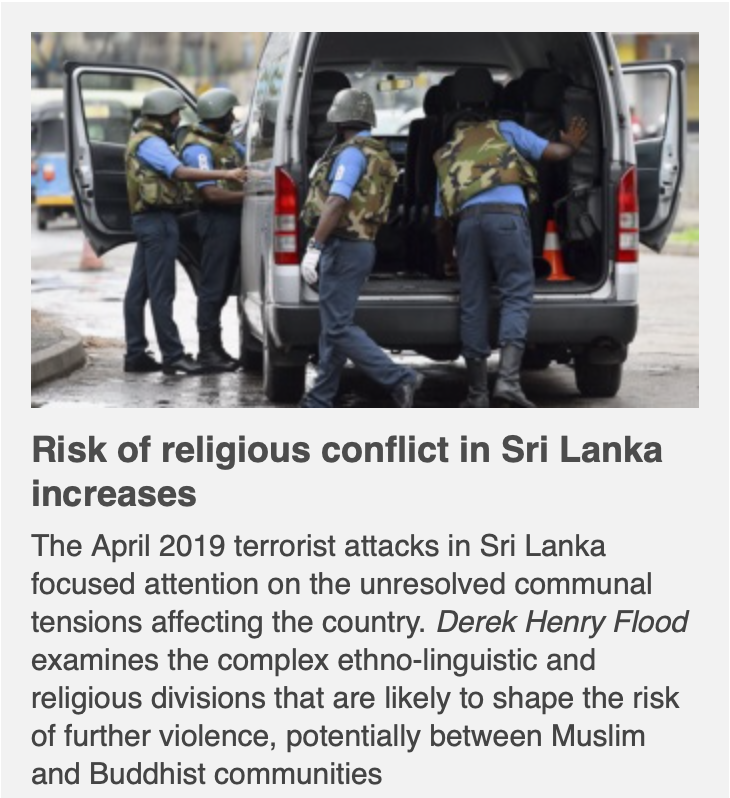
Fremantle- I have a report out this week for Jane’s Intelligence Review from my recent travels in troubled Sri Lanka. I spent a few weeks on the island finishing up work from Syria and simultaneously conducting some field work before the Easter bombings which killed 253 and injured some 500.
I traveled by bus through 5 of the country’s 9 provinces canvasing attitudes of Sinhalese, Tamils, and Muslims who hold themselves to be a distinct ethnic group while overwhelmingly Tamil-speaking at home. To me, the polity seemed as fractious as it was when I lasted visited in March 2007 while the eastern offensive to take Batticaloa was underway (government forces ousted the LTTE from there that July). The country’s central government had not worked in the decade since the war ended to reconcile long-held animosity between communal groups that tend to identify with the armed actors in the conflict.

Sure, Sri Lanka is technically at peace as there is not presently an armed conflict but that should not be mistaken for any kind of healing between Sinhalese and Tamils. Neither side has worked in any significant manner for a post-war harmony. I left with the impression that people get along out of sheer pragmatism rather than any sort of newfound love between north and south. I some of the language people used to describe the other during my visit, it was clear that the Western concept of political correctness had yet to arrive in the pearl of the Indian Ocean.
Once I was in what became the relative safety of northern Thailand’s Mae Hong Son province, terror struck Sri Lanka again. But this time around it was group of acutely radicalised local Sunnis which posthumously portrayed themselves as acting in league with, or in honour of, IS following its territorial demise in eastern Syria’s Deir ez-Zor governorate. Rather than attacking the government directly or its attendant security forces, a team of 9 suicide bombers attacked an array of Catholic sites which straddle the ethnic divide and upscale hotels. Neither of these target selections sync with traditional patterns of of either ethno-linguistic or religio-political violence in Sri Lanka. And that may have been just the point. The salafi-jihadis (often referred to as “Wahabbi” in the press though people rarely self identify with a term) struck out at targets where security was lax, were highly symbolic, would likely produce a high casualty rate necessary for a mass casualty attack, and perhaps most significantly fit neatly within the post-modern narrative arc of globalised Sunni radicalism that pits ‘the Muslims’ in an epic battle with ‘Rome’ ie Christendom. Sri Lanka had no significant history of communal violence between Muslims and Christians, Sunnis and Catholics. There was, however, a long history of LTTE-Muslim violence before the LTTE’s demise precisely 10 years ago this week, overwhelmingly the former brutalising the latter during the 26-year-long war. And much more recently episodic bouts of of Sinhalese-Buddhist-Muslim confrontations in Kandy district etc.
Part of why commentators claim to have been shocked by Sri Lanka being the target for a complex, bi-coastal ‘martyrdom operation’ as suicide attacks are known among salafi’een, is because no one gave a damn about the South Asian island nation. With all eyes on current conflicts in Syria, Iraq and other similar theatres of formalised warfare as well as a deep analytic emphasis on attacks in Western cities (Barcelona, NYC, Nice, Paris), no one was paying much attention to a place once more romantically known as Ceylon. People generally don’t care about places where wars have ended, the flame of the news cycle has long been extinguished. But that was also Afghanistan. Then we had 9/11. People simply weren’t paying attention to that country aside from some Iranian clerics, Pakistani intelligence officers, and women’s rights campaigners in the West at the time.
The decades long war off the southern tip of India didn’t stoke much interest even at its height. Ten years ago this week I contacted an editor at Tina Brown’s Daily Beast just as the war was coming to a bloody conclusion and the LTTE were facing their ultimate defeat about writing an armchair piece from Los Angeles about the last battle and the significance of the death of Vellupilai Prabhkaran, the LTTE’s cult-like ‘supremo’ (leader). The editor, an effete British woman at the time, sent me a delayed reply that she was unsure that the fall of the world’s most technically sophisticated terror group that pioneered much of modern suicide bombing was timely or relevant to their audience. I recall reading the email and thinking to myself, “wow, nothing has changed in the media machine since 9/11. No lesson was learned. It’s still all about ascribed relevance in the myopic minds of gatekeepers.” Timely? The war was ending that week!
So here we are in 2019. Some lessons still not learned by governments, large media organisations, militaries, and so forth. We now live in a world of borderless terrorism. Daunting as it is to state, everything and everywhere must be paid attention to. Ignore at our peril.
A lesson that should be learned from Sri Lanka is that there are serious limitations to predictive terrorism analysis which has become quite the cottage industry for some in the past 18 years. Something about the genie not going back in the bottle, humpty dumpty not going back together, or Pottery Barn’s damaged product policy. Much of that thinking exists inside the box so to speak. But in the grand asymmetry of the phenomenon that is global terrorism, there is no a hard box. Attacks don’t need to recognise borders. We must accept that sometimes we will fail to explain push and pull factors before it’s far too late in a faraway society that seems mostly ok from a facile, removed analysis.
I was in Dubai after leaving Iraq and Syria and made a spontaneous decision to revisit Sri Lanka 12 years on to see what had changed, if anything, beyond the restoration of the country’s territorial integrity. When I left I had a vague, sinking feeling something nasty was going to happen, particularly after a specific, foreboding warning from a contact I’d made in Unawatuna that militant Islam had gained a small but indelible footprint on the island since the war ended. Then Easter morning happened.